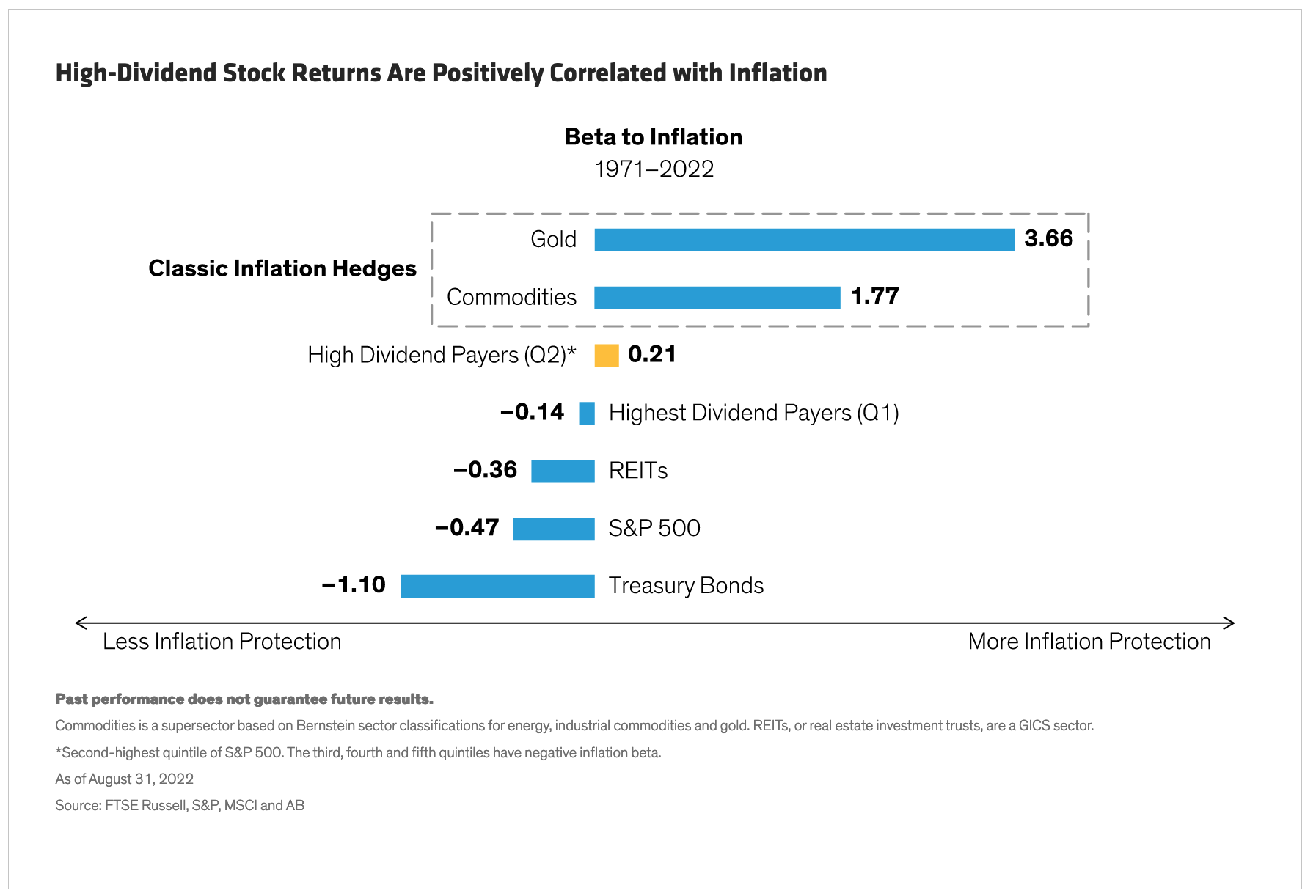by Cem Inal, Chief Investment Officer—US Large Cap Value Equities, Dennis Stakhov, Quantitative Research Analyst—US Value Equities, Snezhana Otto, Senior Research Analyst—Value Equities, AllianceBernstein
Many investors are searching for assets that can help protect portfolios from inflation. Dividend-paying stocks offer surprisingly robust protection from inflation as well as solid long-term return potential in other environments when actively sourced from the right parts of the market.
Surging inflation has challenged investors to adapt to unfamiliar macroeconomic and market conditions. Even after receding slightly in August, US annual inflation remained at 8.3%, an uncomfortably high level last seen over 40 years ago. Rising prices threaten growth, corporate earnings and equity returns and it’s hard to find a compelling investment playbook for such high inflation. Yet it’s hard to predict whether inflation will persist at such extreme levels—and for how long. So how can investors find assets that are likely to perform well in today’s environment but will also do well if inflation recedes?
Classic Inflation Hedges Are Flawed
Some investors might turn to “classic” inflation hedges, such as commodities or real assets. History suggests that these assets tend to perform well in inflationary eras. But if and when inflation retreats, investors might be left in the cold. Assets held for inflation protection, such as commodity stocks or gold, are not reliable sources of long-term returns (Display). On the other hand, high-dividend stocks have delivered stronger risk-adjusted returns over time.
Dividend payers may not be top-of-mind for investors seeking high risk-adjusted returns, because the last decade hasn’t been kind to them. Over seven of the last 10 years through 2021, the MSCI USA High Dividend Yield Index and the FTSE High Dividend Yield Index underperformed the S&P 500. High-dividend payers are often seen as old, stodgy companies, like utilities or food manufacturers, with limited growth potential. As investors flocked to high-flying technology and internet growth companies, dividend stocks seemed like antiquated investment options.
We think the last decade was an anomaly. When widening the lens, we found that stocks in the top two quintiles by dividend yield delivered superior returns over the past four decades. In our view, the second quintile is particularly attractive on a risk-adjusted basis, as it avoids riskier companies with unsustainably high payout ratios. And our research suggests that this long-term return potential comes with a bonus: attractive performance in an inflationary world.
High-Dividend Payers: Inflation Protection and Higher Long-Term Return Potential
Second-quintile dividend payers are among the rarefied ranks of asset classes that have positive beta to inflation (Display), based on our multi-decade analysis going back to when the US last saw similar levels of inflation to today.
Dividend payers are good investments in inflationary times because they tend to have sustainable and relatively predictable cash flows. These cash flows are the lifeblood of payouts to investors and offer a stream of steady income to support returns—if they can be maintained.
That’s the rub.
Finding the right dividend payers always requires a thoughtful, active approach, but especially today. Dividends reflect a company’s ability to generate consistently high free cash flows to distribute to shareholders. Today, investors need to verify that cost inflation and growth pressures won’t squeeze margins and threaten dividend payouts.
How to Find Resilient Business Models Among Dividend Payers
Some business models will be advantaged as inflation rages. We believe companies with pricing power will be able to raise prices without dampening demand. Companies undergoing positive change, or those with sustainable competitive advantages, will also be well positioned to maintain or grow their dividends.
Examples can be found in different parts of the market. Health insurers benefit from higher inflation because they price their book annually but most of their costs are renegotiated for higher rates on a three-year rolling basis. As a result, accelerating inflation is good for their margins. Auto insurers enjoy similar industry dynamics.
In telecommunications, many cable companies are local monopolies or duopolies. So, they can increase their prices to cope with rising costs without losing customers. Fast-food chain franchisors can also withstand inflationary pressures; when prices rise, many consumers trade down to cheaper dining options, and fast-food companies can pass on higher prices with relatively little pushback.
It can be challenging to source the right dividend stocks with passive approaches. Equity income benchmarks gravitate toward the highest dividend payers, without regard for their ability to sustain those payments. Some investors might lean into a value benchmark as a proxy for dividend-paying companies, but these include many energy companies with high volatility and lower return potential in non-inflationary environments.
Inflation has turned the world we live in upside down. Today, inflation is dominating news headlines and market activity. But nobody knows how long severe inflation will persist.
High-dividend payers are a great tool to help investors navigate that uncertainty. They offer a degree of inflation protection without the long-term performance penalty that typically comes with gold or energy. Equity income portfolios that target higher-yielding companies, backed by businesses that can withstand pressure in tougher times, offer a dividend-driven defensive strategy for today’s new and evolving investing challenges.
The views expressed herein do not constitute research, investment advice or trade recommendations and do not necessarily represent the views of all AB portfolio-management teams. Views are subject to change over time.
*****
About the Authors
Cem Inal
Cem Inal was appointed Chief Investment Officer of US Large Cap Value Equities in 2020, after serving as portfolio manager for US Large Cap Value Equities from 2016 until 2019. He was previously a senior research analyst and leader of the technology sector. Inal also co-managed the International Small Cap Value service from its inception in 2014 until 2016. Before joining the firm in 2003 as a research analyst, he was a vice president at fusionOne, a communications software provider. Prior to that, Inal was an engagement manager at McKinsey & Company and a research engineer at Mitsubishi Electric. He holds a BSE in electrical engineering from Princeton University and an MBA in financial engineering from Cornell University. Location: New York
Dennis Stakhov
Dennis Stakhov is a Vice President and Quantitative Research Analyst for US Value Equities. Prior to joining AB in 2018, he was a member of the quantitative strategies team at Columbia Threadneedle Investments. Stakhov holds a BA in mathematics from Hunter College and an MS in computational finance from Carnegie Mellon University. Location: New York
Snezhana Otto
Snezhana Otto is a Vice President and Senior Research Analyst for Value Equities, covering US consumer discretionary and healthcare. Prior to joining AB in 2018, she was an associate partner at McKinsey & Company, where she was a part of the Strategy & Corporate Finance practice, working primarily with healthcare clients on topics ranging from activist-investor strategy to cost-optimization programs. Otto holds a BA in economics (with honors) from Harvard University; an MBA (with high distinction) from Harvard Business School, where she was a George F. Baker Scholar; and an MPA in International Development from the Harvard Kennedy School. Location: New York
Copyright © AllianceBernstein

















